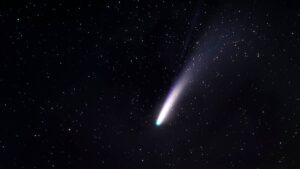Victoria’s gold renaissance: Southern Cross Gold heading for a golden IPO

Pic: Bloomberg Creative / Bloomberg Creative Photos via Getty Images
Could it be that the long hoped for renaissance of the Victorian gold industry has finally arrived? It certainly looks that way.
There have been false dawns before. But there seems little doubt this time. There’s no arguing with some of these numbers – industry expenditure and production figures do not lie.
Exploration for the yellow metal in the State that was made by the 1850s gold rush has surged to record levels, climbing 83% to $150 million in 2020-21, and production has more than doubled since 2017-18 to 720,000 ounces.
A rebirth
There are three key factors behind the renaissance – the discovery of high-grade grade at depth below the historic and Canadian-owned Fosterville mine near Bendigo, a subsequent rush of Canadian money into the sector, and the rise in gold prices to historically high levels.
Fosterville (now owned by Agnico Eagle) got its first indication of high-grade mineralisation in the Eagle Zone in the Lower Phoenix area of the Fosterville mine in around 2014
Fosterville, then owned by Kirkland Lake Gold followed up with the 2016 discovery of the super high-grade Swan Zone (up to 60 grams of gold a tonne and with a last stated reserve position of 1.25 million tonnes grading 30.6g/t, or almost one ounce a tonne).
Golden Swan
Fosterville traces its history back to the 1890s but its revival in the modern era under various owners was a scrappy affair, initially based as it was on the mining of oxide gold pits, and then marginal refractory sulphide ore from underground operations.
Then the Swan Zone came along.
The subsequent surge in Victoria’s gold production can’t be put down to the fabled Swan Zone discovery alone, with a rebooted Stawell mine, owned by private equity interests, and the Costerfield gold-antimony mine of Canada’s Mandalay Resources, also contributing to the increase.
Make my mine a Fosterville
Fosterville is now one of the world’s great gold mines and it had a telling impact on the growth in Kirkland Lake’s market cap in its Canadian home market in the lead up to the merger with Agnico Eagle.
Excited by Fosterville’s high grades and extreme profitability per ounce of production, other Canadian miners and explorers have flooded into Victoria looking for the “next’’ Fosterville.
They joined local industry exploration stalwarts such as the “new’’ Bendigo hunters Navarre and Catalyst, and newcomer explorers like Carawine and the recently listed Falcon Metals.
The boom in activity is reflected in the number of new mineral licences being issued in Victoria more than doubling to over 100 last year.
A rich history
Victoria’s rich gold history is well known.
More than 80 million ounces has been mined since 1851, with about one-quarter of its land mass considered by boffins to effectively represent one giant orogenic goldfield, split by age in to two distinct subtypes, mesozonal (Bendigo and Stawell) and epizonal (Fosterville and Costerfield).
Importantly, the Swan Zone discovery at Fosterville, and Mandalay’s success at Costerfield (the two are amongst the world’s highest grade gold operations), has expanded the “search space’’ for more high-grade epizonal gold at depth beneath historic goldfields in Victoria.
The expanded epizonal search space is the focus of Southern Cross Gold which is being spun-out of Toronto-listed Mawson Gold in an IPO on the ASX seeking to raise $8-$10 million.
Mawson has been active in Victoria since 2020 after picking up three epizonal gold projects (100% and in joint ventures) from the ASX-listed Nagambie Resources.
But Victoria’s gold exploration potential has been of keen interest to Mawson’s executive chairman, and Southern Cross managing director, Melbourne geologist Michael Hudson, long before the deal with Nagambie, now owned 10% by Southern Cross.
He was a project vendor and shareholder in the 2006 listing of Nagambie’s predecessor, Panaegis Gold, ahead of his co-founding of Mawson which after the spin-off of Southern Cross, will focus on its 1 million ounce gold discovery in Finland.
Hudson said the Swan Zone discovery at Fosterville had opened up a, “new search space in a world class gold district.’’
“Nobody had put much effort into looking for this very late (geologically) gold before. It has been known about in the technical world for ever. But the commercial light bulb only came on with the Swan zone discovery,’’ Hudson said.
In the land of the…
Southern Cross comes to the ASX as an advanced explorer as Mawson has spent more than $6 million exploring its three epizonal gold (and antimony) targets in central Victoria – Sunday Creek (100%) on Melbourne’s doorstep, Whroo (earning 70%) 40km east of Fosterville, and Redcastle (earnt 70%) due northof the Costerfield mine and essentially it mine lease extensions. .
The Sunday Creek gold-antimony project is the most advanced and has been the subject of 26 holes by Mawson/Southern Cross. Southern Cross non-executive chairman, the veteran geologist Tom Eadie of Pasminco and Syrah fame, reckons it is one of the, “best new exploration discoveries to come out of Victoria in recent times.’’
Exploration momentum at the project has been maintained in the lead up to the Southern Cross IPO thanks to a $2.7 million private in the company late last year, reducing Mawson to an 84.62% stake (and 58.31% on the IPO raising $10 million).
The last drill result reported by Mawson ahead of an expected May listing of Southern Cross returned a high-grade hit of 5.6 metres grading 10g/t gold equivalent (9.2g/t gold and 0.8% of the antimony mineral stibnite) from 469.7 metres.
Getting the band back together
It is the deepest high-grade intersection to date at Sunday Creek, down vertically at 420 metres and was drilled on the same mineralised shoot, 130 metres west and below, which previously returned an 11.7 metre intersection grading 16g/t gold equivalent late last year.
As noted by Hudson, the mineralisation remains open at depth, and the system continues 10km to the east covering historic mines.
At the 14km historic Whroo goldfield, historically the deepest hole ever drilled only went to 100 metres. Southern Cross has just drilled to 200 metres depth and returned the best result on the field since mining ceased 167 years ago.
“We have just drilled under that in the last few months and we pulled up a half dozen high grade zones that look very much like Costerfield,’’ Hudson said. The results included grades of up to 50g/t over 0.6m, and 0.2m grading 16.5% antimony.
Housing Mawson’s Victorian gold hunt in Southern Cross is particularly pleasing for Hudson. “The IPO is a way of bringing ownership back home,’’ he said. Having Eadie as chairman – he was Hudson’s boss for 10 years at Pasminco – is also pleasing.
“It’s like the Blues Brothers getting back together,’’ Hudson said.
This article was developed in collaboration with Mawson Gold / Southern Cross Gold, Stockhead advertisers at the time of publishing.
This article does not constitute financial product advice. You should consider obtaining independent advice before making any financial decisions.
Related Topics

UNLOCK INSIGHTS
Discover the untold stories of emerging ASX stocks.
Daily news and expert analysis, it's free to subscribe.
By proceeding, you confirm you understand that we handle personal information in accordance with our Privacy Policy.








